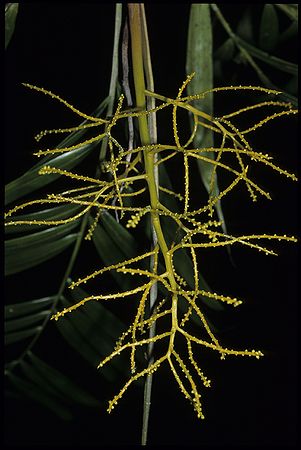Dypsis confusa
| Dypsis (DIP-sis) confusa (kohn-FOO-sah) | |||||||
|---|---|---|---|---|---|---|---|
 Masoala, Madagascar. Photo by Dr. John Dransfield, Royal Botanic Gardens, Kew/Palmweb. | |||||||
| Scientific Classification | |||||||
| |||||||
| Synonyms | |||||||
|
| |||||||
| Native Continent | |||||||
|
| |||||||
| Morphology | |||||||
| |||||||
| Culture | |||||||
|
| |||||||
| Survivability index | |||||||
|
| |||||||
| Common names | |||||||
|
| |||||||
Contents
Habitat and Distribution
Endemic to Madagascar. Masoala, Mananara and Betampona. Lowland rain forest or peat swamp forest; flat ground or ridge top; alt. 5-300 (-900) m.Description
Solitary or clustering palm. STEMS 3-7 m tall, (Cours 1904 says 15 m), 1-4 cm in diam.; internodes 1-11 cm long, green with some brown scales distally; nodal scars about 5 mm; crownshaft about 40 cm long, pale green with brown or reddish scales; wood white, hard. LEAVES 5-8 in the crown, pinnate; sheath 12-25 cm long, pale green, densely red-scaly but glabrescent (Perrier 15012: with irritant hairs), with rounded, ragged shoulders or with auricles to 1.5 cm long, the outer half open; petiole 3-32 cm long, 3-6 x 2-4 mm in diam., with scattered brown scales; rachis 49-86 cm long, in mid-leaf 2.5-5 mm wide, with scattered scales or glabrous; leaflets 11-28 on each side of the rachis, in groups of 2-4 (-8) and in one plane or in slightly ascending fans, group interval 4-14 cm, the proximal 14-37 x 0.2-3.2 cm, median 21-36 x 0.7-2.6 cm, distal 8-20 x 0.2-2.6 cm, connate for 1.5-3 cm, main veins 1 (-3), in the distal pair 2-3, ramenta rarely present, faint reddish glands/scales present on the minor veins, plus occasionally in marginal bands, apices attenuate, unequal, distal pair dentate over a width of 5-6 mm. INFLORESCENCE interfoliar, branched to 2 orders, erect; peduncle 20-37 cm long, 2.5-12 x 2-6 mm in diam., densely reddish pubescent; prophyll 13-29 cm long, 0.9-1.5 cm wide, borne at 5-14 cm above the base of the peduncle, with scattered scales, open in the distal 1.5-7 cm; peduncular bract inserted at 2-25 cm from the base of the peduncle, 17-24 cm long, green with scattered scales, split over its B length, with a beak of up to 1.5 cm, circumscissile; rachis 10-36 cm long, scaly, with 8-18 branched and 8-17 unbranched first order branches, the proximal with an axis of up to 8 cm long and with up to 11 second order branches; rachillae yellow to orange, 2.5-15 cm long, about 1 mm in diam., minutely scaly/puberulous to glabrous. STAMINATE FLOWERS with sepals 0.6-1 x 0.7-1.3 mm; petals 1.9-2.5 x 1.2-1.7 mm, orange; stamens 6, 1- to biseriate, filaments 0.9-1 mm, thin, anthers 1.1-1.4 x 0.6-0.7 mm, dorsifixed, not versatile; pistillode 0.6- 0.8 x 0.3-0.5 mm. PISTILLATE FLOWERS with sepals 0.8-1 x 1.1-1.3 mm; petals 1.8-2.3 x 1.8-2.2 mm; staminodes 0.2-0.4 mm; pistil only seen as young fruit. FRUIT orange to red, ellipsoid with a pointed apex, 6-10 x 3-5 mm. SEED 3-5 x 2.5-3.5 mm, with homogeneous endosperm. (J. Dransfield and H. Beentje. 1995)/Palmweb. Editing by edric.
Most of all this species reminds us of D. scottiana from which it differs in the leaflets with scattered scales abaxially, and the longer staminate petals; the rest is gradual: rachis, group interval, leaflets and rachillae are as long as, or slightly longer than specimens of D. scottiana. It also resembles D. hiarakae, from which it is only distinct by the length of the rachilla. Moramanga: Mantady, Dec. 1991 (fl.), Beentje & Andriampaniry 4545 (K, TAN) keys out as this taxon, but looks quite different. It is clustering with overhanging stems; petiole 0.5-1 cm, leaflets 23-26 on each side of the rachis, almost regular, the median 13-16 x 0.9-1 cm; rachillae 10-13 cm. Similar are: Mandritsara/Andilamena: N of Andilamena, Nov. 1929 (bud), Perrier 15012 (P). Ambatondrazaka: Ambatondrazaka, Dec. 1944 (bud), Homolle 548 (K, P). (J. Dransfield and H. Beentje. 1995)/Palmweb.
Culture
Cold Hardiness Zone: 10a
Comments and Curiosities
The specific epithet derives from the fact that of the first four specimens we saw two had been named as Neophloga, and the other two as Dypsis and Phloga respectively. It is indeed a palm looking like several other taxa at the same time! (J. Dransfield and H. Beentje. 1995)/Palmweb.
Conservation: Rare, possibly Vulnerable. Found in several sites, but only one of these is in a protected area. Numbers are thought to be low. (J. Dransfield and H. Beentje. 1995)/Palmweb.
Uses: Stems used to make blowpipes for poison darts.
A smallish Dypsis, close to D. scottiana and native to wet lowland forests in northeastern Madagascar. Its thin stems can reach a height of up to 7 m (23 ft.), the leaves hold narrow leaflets arranged in small groups. In cultivation it presently is hardly found but would be best suited for the humid tropics. (RPS.com)
- IMAGE GALLERY
External Links
References
Phonetic spelling of Latin names by edric.
Special thanks to Geoff Stein, (Palmbob) for his hundreds of photos.
Special thanks to Palmweb.org, Dr. John Dransfield, Dr. Bill Baker & team, for their volumes of information and photos.
Glossary of Palm Terms; Based on the glossary in Dransfield, J., N.W. Uhl, C.B. Asmussen-Lange, W.J. Baker, M.M. Harley & C.E. Lewis. 2008. Genera Palmarum - Evolution and Classification of the Palms. Royal Botanic Gardens, Kew. All images copyright of the artists and photographers (see images for credits).
Dransfield, J. & Beentje, H. 1995. The Palms of Madagascar. Royal Botanic Gardens, Kew and The International Palm Society.
Many Special Thanks to Ed Vaile for his long hours of tireless editing and numerous contributions.





